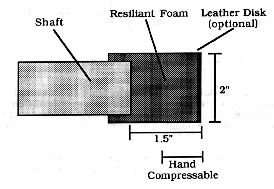
Javelineers and fighters throwing hand darts may hold both one or more projectiles and a legal hand weapon or shield simultaneously, provided they have legal hand protection for both hands.
All projectiles shall be clearly marked to indicate the owner of the projectile. This may be a crest registered with the Marshal-in-Charge or preferably the name and area of the owner.
Target areas for javelins and hand darts are the same as for arrows.
Hand darts may only be used in Heavy Weapons combat.
The shafts of all Javelins shall be spiral or linearly wrapped with fiber strapping tape with the wraps overlapping. It is recommended that duct tape be applied over the fiber tape to help protect against the sun.
No javelin may be artificially weighted with clay, lead, water, or any material other than tape and foam. All javelins shall weigh no more than 2.5 pounds.
Javelins may be fitted with fins, constructed of resilient foam, PVC pipe or equivalent material (no rigid material that presents an edge). No fin construction shall allow a javelin fin to extend more than 0.5" into a legal helm. Alternately a javelin may be outfitted with a streamer made of 1" or wider cloth to aide in its flight (although this is not the recommended technique).

Javelin heads shall be constructed of no less than 1.5" of resilient foam at least 2.0" wide. The end of the javelin may be fitted with a 2.0" leather disk if desired. The resilient foam must be compressible by hand approximately 0.75" without being able to feel the edge of the PVC tubing. If the end of the shaft is not sealed with a PVC, schedule-40 cap, the javelin should be inspected after each use to verify that the PVC tube has not 'punched through' the resilient foam. The tip shall be firmly attached to the shaft with fiber strapping tape.
Standard Hand Darts are constructed in the same manner as Heavy Weapons Combat Arrows, with three exceptions: the golf tube shaft may be from 12 to 18 inches long; the tennis ball head may be filled with unpopped popcorn for ballast; and the tennis ball head must be covered with black tape and have a cross of silver duct tape. The silver cross should be able to be seen from all angles that the dart would normally be held. No part of the hand dart may be colored red (to prevent confusion with combat arrows). Hand darts may not have fins or streamers.
Javelins, hand darts, and golf tube arrows are all considered separate types of projectiles and construction methods may not be mingled except as specifically mentioned in these rules.
Non-fighters can be authorized to participate in heavy and light weapons battles as scouts or banner bearers by demonstrating that they can equip themselves in legal armor for the type of combat being performed and are knowledgeable about the rules of the list.
Scouts and Banner Bearers must be armored as a legal fighter for the appropriate type of combat.
Scouts and Banner Bearers may be killed as normal fighters and may yield rather than allowing themselves to hit by placing a gauntleted hand over their head an saying LOUDLY, "I YIELD". They then must leave the field like any other killed fighter.
All scouts or banner bearers that are killed or have yielded shall leave the field with their hands raised above their heads so that other participants may know that they have been killed.
Any individual authorized as only a Scout or Banner Bearer that is caught wielding or carrying weapons (other than gleaning arrows in archery scenarios) shall be banned from the field.
Have Scouts and Banner Bearers take the written test on the back of the Light Weapons Form.
If the participate is passed, validate their fighter card for the appropriate skill as follows:
Banner Bearer/Scout:.......... BBS/your initials
Siege engines should attempt to duplicate period (but pre-gunpowder) techniques and appearances. Non-period components should be disguised. All projectile hits are judged as combat arrows unless modified and announced by the autocrat.
Those wishing to build or shoot siege engines should contact the Earl Marshal (well in advance) for further guidelines.
All weapons that use a charge of burning or explosive gases, or compressed gasses are explicitly prohibited.
| Caid Combat Handbook - Volume II | 8/30/95 |